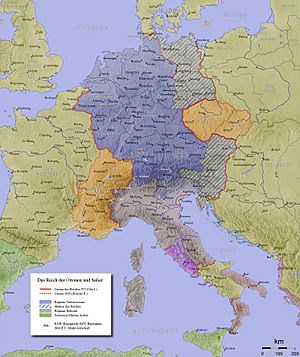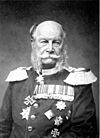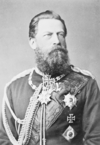List of German monarchs facts for kids
This article lists the kings and emperors who ruled over parts of what is now Germany. It covers the period from the year 843, when the large Frankish Empire was divided, all the way to 1918, when the German Empire ended. These rulers were important figures in shaping the history of Germany.
Contents
Kings of East Francia (843–962)
After the Frankish Empire split in 843, the eastern part became known as East Francia. This area was the beginning of what would later become Germany.
The Carolingian Family (843–911)
| Picture | Name | Became King | Became Emperor | Ended Rule | Important Facts | R. |
|---|---|---|---|---|---|---|
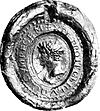 |
Louis II the German (Ludwig der Deutsche) |
c.August 10, 843 | — | August 28, 876 | He was the son of Emperor Louis the Pious and the grandson of Charlemagne. | |
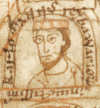 |
Carloman (Karlmann) |
August 28, 876 | — | March 22, 880 | Son of Louis the German. He ruled in Bavaria and also became King of Italy in 876. | |
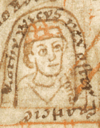 |
Louis III the Younger (Ludwig der Jüngere) |
March 22, 880 | — | January 20, 882 | Son of Louis the German. He ruled in East Francia and Saxony. From 880, he also ruled Bavaria. | |
 |
Charles III the Fat (Karl der Dicke) |
January 20, 882 | February 12, 881 | c.November 17, 887 | Son of Louis the German. He ruled in Alemannia and Raetia. From 882, he ruled the entire Eastern Kingdom. He was also King of Italy from 879. | |
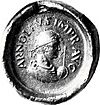 |
Arnulf of Carinthia (Arnulf von Kärnten) |
c.November 27, 887 | April 25, 896 | December 8, 899 | He was the son of Carloman. | |
 |
Louis IV the Child (Ludwig das Kind) |
December 8, 899 | — | September 24, 911 | He was the son of Arnulf of Carinthia. |
The Conradine Family (911–918)
| Picture | Name | Became King | Became Emperor | Ended Rule | Important Facts | R. |
|---|---|---|---|---|---|---|
 |
Conrad I (Konrad I.) |
November 10, 911 | — | December 23, 918 | He was chosen by the nobles to be king. |
The Ottonian Family (919–962)
| Picture | Name | Became King | Became Emperor | Ended Rule | Important Facts | R. |
|---|---|---|---|---|---|---|
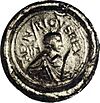 |
Henry I the Fowler (Heinrich I. der Vogler) |
May 14 / 24, 919 | — | July 2, 936 | He was chosen by the nobles to be king. | |
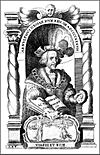 |
Arnulf the Evil (Arnulf der Böse) |
919 | — | 921 | He was a rival king to Henry I. He was a member of the Luitpoldings family. |
Rulers of the Holy Roman Empire (962–1806)
The title "King of the Romans" was used in the Holy Roman Empire. From the time of Henry II, this title was like being the King of Germany. A king was chosen by German electors (important princes). Then, he would travel to Rome to be crowned emperor by the Pope.
The Ottonian Family Continues (962–1024)
| Picture | Name | Became King | Became Emperor | Ended Rule | Important Facts |
|---|---|---|---|---|---|
 |
Otto I the Great (Otto I. der Große) |
July 2, 936 | February 2, 962 | May 7, 973 | Son of Henry I. He was the first king crowned in Aachen Cathedral since Lothair I. He was crowned as Otto, King by the grace of God. He became Holy Roman Emperor in 962. |
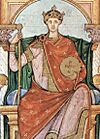 |
Otto II the Red (Otto II. der Rote) |
May 26, 961 | December 25, 967 | December 7, 983 | Son of Otto I. He was King under his father from 961 to 973. He was also crowned emperor while his father was still alive. |
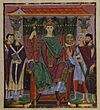 |
Otto III (Otto III.) |
December 25, 983 | May 21, 996 | January 21, 1002 | Son of Otto II. He was King by the grace of God. |
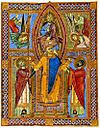 |
Henry II the Saint (Heinrich II. der Heilige) |
June 7, 1002 | April 26, 1014 | July 13, 1024 | He was the great-grandson of Henry I. |
The Salian Family (1024–1125)
| Picture | Name | Became King | Became Emperor | Ended Rule | Important Facts |
|---|---|---|---|---|---|
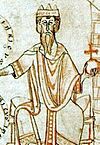 |
Conrad II (Konrad II.) |
September 8, 1024 | March 26, 1027 | June 4, 1039 | He was the great-great-grandson of Otto I. |
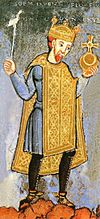 |
Henry III (Heinrich III.) |
April 14, 1028 | December 25, 1046 | October 5, 1056 | Son of Conrad II. He was King under his father from 1028 to 1039. |
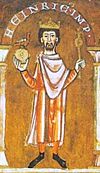 |
Henry IV (Heinrich IV.) |
July 17, 1054 | March 21, 1084 | December 31, 1105 | Son of Henry III. He was King of Germany under his father from 1054 to 1056. |
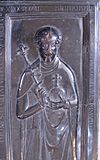 |
Rudolf of Rheinfelden (Rudolf von Rheinfelden) |
March 15, 1077 | — | October 15, 1080 | He was a rival king to Henry IV. He was a member of the Rheinfeld family. |
 |
Hermann of Salm (Hermann von Salm) |
August 6, 1081 | — | September 28, 1088 | He was a rival king to Henry IV. He was a member of the Salm family. |
 |
Conrad (Konrad) |
May 30, 1087 | — | July 27, 1101 | Son of Henry IV. He was King of Germany under his father from 1087 to 1098. He was also King of Italy from 1093 to 1098, and from 1095 to 1101 during a rebellion. |
 |
Henry V (Heinrich V.) |
January 6, 1099 | April 13, 1111 | May 23, 1125 | Son of Henry IV. He was King of Germany under his father from 1099 to 1105. He forced his father to give up the throne. |
The Supplinburger Family (1125–1137)
| Picture | Name | Became King | Became Emperor | Ended Rule | Important Facts |
|---|---|---|---|---|---|
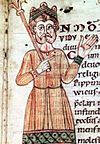 |
Lothair III (Lothar III.) |
September 13, 1125 | June 4, 1133 | December 4, 1137 | He was known as Lothair II in Germany, but Lothair III in Italy. |
The Hohenstaufen Family (1138–1254)
| Picture | Name | Became King | Became Emperor | Ended Rule | Important Facts |
|---|---|---|---|---|---|
 |
Conrad III (Konrad III.) |
March 7, 1138 | — | February 15, 1152 | Grandson of Henry IV (through his mother). He was a rival king to Lothair III from 1127 to 1135. |
| Henry Berengar (Heinrich (VI.)) |
March 30, 1147 | — | August? 1150 | Son of Conrad III. He was King of Germany under his father from 1147 to 1150. | |
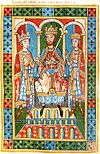 |
Frederick I Barbarossa (Friedrich I. Barbarossa) |
March 4, 1152 | June 18, 1155 | June 10, 1190 | Nephew of Conrad III. |
 |
Henry VI (Heinrich VI.) |
August 15, 1169 | April 15, 1191 | September 28, 1197 | Son of Frederick I. He was King of Germany under his father from 1169 to 1190. |
 |
Frederick II (Friedrich II.) |
1197 | — | 1197 | Son of Henry VI. He was King of Germany under his father in 1196. |
 |
Philip of Swabia (Philipp von Schwaben) |
March 8, 1198 | — | June 21, 1208 | Son of Frederick I. He was a rival king to Otto IV. |
 |
Otto IV (Otto IV.) |
June 9, 1198 | October 21, 1209 | 1215 | Great-grandson of Lothair III. He was a member of the House of Welf. He was later opposed by Frederick II. He was removed from power in 1215 and died on May 19, 1218. |
 |
Frederick II (Friedrich II.) |
December 5, 1212 | November 22, 1220 | December 26, 1250 | Son of Henry VI. He was a rival king to Otto IV until July 5, 1215. |
 |
Henry (Heinrich (VII.)) |
April 1220 | — | July 2, 1235 | Son of Frederick II. He was King of Germany under his father from 1220 to 1235. |
 |
Conrad IV (Konrad IV.) |
February 1237 | — | May 21, 1254 | Son of Frederick II. He was King of Germany under his father from 1237 to 1250. |
The Time Without an Emperor (1254–1273)
This period was called the "Interregnum," meaning "between reigns." There was no strong emperor ruling the Holy Roman Empire.
| Picture | Coat of Arms | Name | Family | Became King | Became Emperor | Ended Rule | Important Facts |
|---|---|---|---|---|---|---|---|
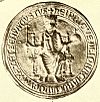 |
 |
Henry Raspe (Heinrich Raspe) |
Thuringia | May 22, 1246 | — | February 16, 1247 | He was a rival King to Frederick II. He was also the great-great-great grandson of Henry IV. |
 |
 |
William of Holland (Wilhelm von Holland) |
Holland | October 3, 1247 | — | January 28, 1256 | He was a rival King to Frederick II and Conrad IV from 1247 to 1254. |
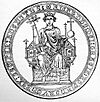 |
 |
Richard of Cornwall (Richard von Cornwall) |
Plantagenet | January 13, 1257 | — | April 2, 1272 | He was the brother-in-law of Frederick II. He was a rival king to Alfonso of Castile but had no real power. |
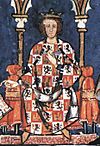 |
 |
Alfonso of Castile (Alfons von Kastilien) |
House of Ivrea | April 1, 1257 | — | 1275 | He was the grandson of Philip. He was a rival king to Richard of Cornwall and had no real power. He gave up his claims in 1275 and died in 1284. |
Different Ruling Families (1273–1438)
| Picture | Coat of Arms | Name | Family | Became King | Became Emperor | Ended Rule | Important Facts |
|---|---|---|---|---|---|---|---|
 |
 |
Rudolf I (Rudolf I. von Habsburg) |
Habsburg | September 29, 1273 | — | July 15, 1291 | He was the first ruler from the Habsburg family. |
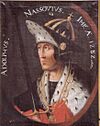 |
Adolf of Nassau (Adolf von Nassau) |
Nassau | May 5, 1292 | — | June 23, 1298 | Some historians believe that Conrad, Duke of Teck was king for a short time before Adolf. | |
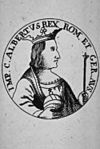 |
 |
Albert I (Albrecht I. von Habsburg) |
Habsburg | June 24, 1298 | — | May 1, 1308 | Son of Rudolf I. He was a rival king to Adolf of Nassau in 1298. |
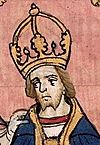 |
 |
Henry VII (Heinrich VII.) |
Luxembourg | November 27, 1308 | June 29, 1312 | August 24, 1313 | He was a Holy Roman Emperor. |
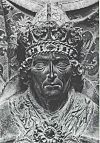 |
 |
Louis IV (V) the Bavarian (Ludwig der Bayer) |
Wittelsbach | October 20, 1314 | January 17, 1328 | October 11, 1347 | Grandson of Rudolf I. He was a rival king to Frederick the Fair from 1314 to 1322. |
 |
 |
Frederick the Fair (Friedrich der Schöne) |
Habsburg | October 19, 1314/ September 5, 1325 |
— | September 28, 1322/ January 13, 1330 |
Son of Albert I. He was a rival king to Louis IV from 1314 to 1322. He was an associate king with Louis IV from 1325 to 1330. |
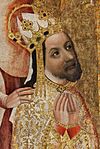 |
 |
Charles IV (Karl IV.) |
Luxembourg | July 11, 1346 | April 5, 1355 | November 29, 1378 | Grandson of Henry VII. He was a rival king to Louis IV from 1346 to 1347. He was also King of Bohemia, King of Italy and Holy Roman Emperor. |
 |
 |
Günther von Schwarzburg (Günther von Schwarzburg) |
Schwarzburg | January 30, 1349 | — | May 24, 1349 | He was a rival king to Charles IV. |
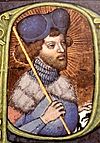 |
 |
Wenceslaus (Wenzel von Böhmen) |
Luxembourg | June 10, 1376 | — | August 20, 1400 | Son of Charles IV. He was King of Germany under his father from 1376 to 1378. He was removed from power in 1400 and died in 1419. He was also King of Bohemia. |
 |
 |
Rupert of the Palatinate (Ruprecht von der Pfalz) |
Wittelsbach | August 21, 1400 | — | May 18, 1410 | He was the great-grandnephew of Louis IV. |
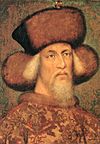 |
 |
Sigismund (Sigismund) |
Luxembourg | September 10, 1410 /July 21, 1411 |
May 3, 1433 | December 9, 1437 | Son of Charles IV. |
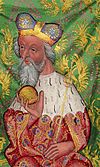 |
 |
Jobst of Moravia (Jobst von Mähren) |
Luxembourg | October 1, 1410 | — | January 8, 1411 | Nephew of Charles IV. He was a rival king to Sigismund. |
The Habsburg Family (1438–1740)
| Picture | Coat of Arms | Name | Became King | Became Emperor | Ended Rule | Important Facts |
|---|---|---|---|---|---|---|
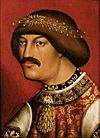 |
 |
Albert II (Albrecht II.) |
March 18, 1438 | — | October 27, 1439 | He was the 4th generation descendant of Albert I. He was also the son-in-law of Sigismund. |
 |
 |
Frederick III (Friedrich III.) |
February 2, 1440 | March 16, 1452 | August 19, 1493 | He was the 4th generation descendant of Albert I and the second cousin of Albert II. |
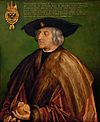 |
 |
Maximilian I (Maximilian I.) |
February 16, 1486 | February 4, 1508 | January 12, 1519 | Son of Frederick III. He was King of Germany under his father from 1486 to 1493. He took the title "Elected Emperor" in 1508 with the Pope's approval. |
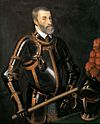 |
 |
Charles V (Karl V.) |
June 28, 1519 | June 28, 1519 | August 3, 1556 | Grandson of Maximilian I. He died on September 21, 1558. He was the last Emperor to be crowned by the Pope. |
 |
 |
Ferdinand I (Ferdinand I.) |
January 5, 1531 | August 27, 1556 | July 25, 1564 | Grandson of Maximilian I and brother of Charles V. He was King of Germany under his brother Charles V from 1531 to 1556. He was the last king to be crowned in Aachen Cathedral. |
 |
 |
Maximilian II (Maximilian II.) |
November 22, 1562 | July 25, 1564 | October 12, 1576 | Son of Ferdinand I. He was King of Germany under his father from 1562 to 1564. |
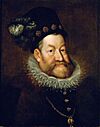 |
 |
Rudolf II (Rudolf II.) |
October 27, 1575 | October 12, 1576 | January 20, 1612 | Son of Maximilian II. He was King of Germany under his father from 1575 to 1576. |
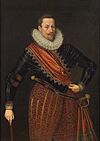 |
 |
Matthias (Matthias) |
June 13, 1612 | June 13, 1612 | March 20, 1619 | Son of Maximilian II. |
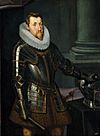 |
 |
Ferdinand II (Ferdinand II.) |
August 28, 1619 | August 28, 1619 | February 15, 1637 | Grandson of Ferdinand I. |
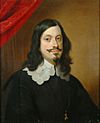 |
 |
Ferdinand III (Ferdinand III.) |
December 22, 1636 | February 15, 1637 | April 2, 1657 | Son of Ferdinand II. He was King of Germany under his father from 1636 to 1637. |
 |
 |
Ferdinand IV (Ferdinand IV.) |
May 31, 1653 | — | July 9, 1654 | Son of Ferdinand III. He was King of Germany under his father. |
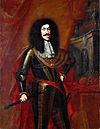 |
 |
Leopold I (Leopold I.) |
July 18, 1658 | July 18, 1658 | May 5, 1705 | Son of Ferdinand III. |
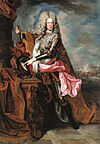 |
 |
Joseph I (Joseph I.) |
January 23, 1690 | May 5, 1705 | April 17, 1711 | Son of Leopold I. He was King of Germany under his father from 1690 to 1705. |
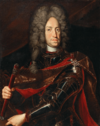 |
 |
Charles VI (Karl VI.) |
October 12, 1711 | October 12, 1711 | October 20, 1740 | Son of Leopold I. |
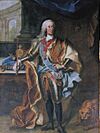 |
 |
Charles VII (Karl VII.) |
January 24, 1742 | January 24, 1742 | January 20, 1745 | He was a member of the House of Wittelsbach. He was the great-great-grandson of Ferdinand II. He was married to Maria Amalia, who was the daughter of Joseph I. |
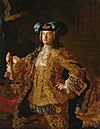 |
 |
Francis I (Franz I.) |
September 13, 1745 | September 13, 1745 | August 18, 1765 | He was the husband of Maria Theresa I. |
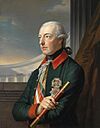 |
 |
Joseph II (Joseph II.) |
March 27, 1764 | August 18, 1765 | February 20, 1790 | Son of Maria Theresa I and Francis I. He was King of Germany under his mother and father from 1764 to 1765. |
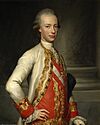 |
 |
Leopold II (Leopold II.) |
September 30, 1790 | September 30, 1790 | March 1, 1792 | Son of Maria Theresa I and Francis I. |
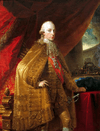 |
 |
Francis II (Franz II.) |
July 5, 1792 | July 5, 1792 | August 6, 1806 | Son of Leopold II. He ended the Holy Roman Empire. He was also Emperor of Austria from 1804 to 1835. He was President of the German Confederation from 1815 to 1835 and died in 1835. |
Germany in Modern Times (1806–1918)
After the Holy Roman Empire ended, Germany went through several changes in its political structure.
The Confederation of the Rhine (1806–1813)
| Name | Picture | Title | Family | Began | Ended |
|---|---|---|---|---|---|
| Napoleon I Emperor of the French King of Italy |
 |
Protector of the Confederation of the Rhine |  Bonaparte |
July 12, 1806 | October 19, 1813 |
| Eugène de Beauharnais, Grand Duke of Frankfurt |
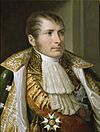 |
Prince-primate of the Confederation of the Rhine |
 Beauharnais |
October 26, 1813 | December 1813 |
| Karl Theodor von Dalberg, Prince-Archbishop of Regensburg Grand Duke of Frankfurt |
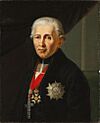 |
Prince-primate of the Confederation of the Rhine |
 Dalberg |
July 25, 1806 | October 26, 1813 |
The German Confederation (1815–1866)
| Name | Picture | Title | Family | Began | Ended |
|---|---|---|---|---|---|
| Francis I, Emperor of Austria (Franz I., Kaiser von Österreich) |
 |
Head of the presiding power
(Präsidialmacht) Austria |
 Habsburg-Lorraine |
June 20, 1815 | March 2, 1835 |
| Ferdinand I, Emperor of Austria (Ferdinand I., Kaiser von Österreich) |
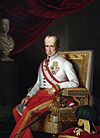 |
Head of the presiding power (Präsidialmacht) Austria |
 Habsburg-Lorraine |
March 2, 1835 | July 12, 1848 |
| Archduke John of Austria (Erzherzog Johann von Österreich) |
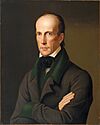 |
Regent (Reichsverweser) of the revolutionary German Empire |
 Habsburg-Lorraine |
July 12, 1848 | December 20, 1849 |
| Frederick William IV, King of Prussia (Friedrich Wilhelm IV., König von Preußen) |
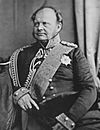 |
Emperor of the Germans elect |  Hohenzollern |
March 28, 1849 | April 28, 1849 |
| Presidium of the Union (Unionsvorstand) of the Erfurt Union |
May 26, 1849 | November 29, 1850 | |||
| Francis Joseph I, Emperor of Austria (Franz Joseph I., Kaiser von Österreich) |
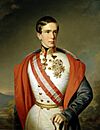 |
Head of the presiding power (Präsidialmacht) Austria |
 Habsburg-Lorraine |
May 1, 1850 | August 24, 1866 |
The North German Confederation (1867–1871)
| Name | Picture | Title | Family | Began | Ended |
|---|---|---|---|---|---|
| Wilhelm I, King of Prussia (Wilhelm I, König von Preußen) |
Holder of the Bundespräsidium of the North German Confederation |
 Hohenzollern |
July 1, 1867 | January 1, 1871 |
The German Empire (1871–1918)
| Name | Picture | Family | Began | Ended |
|---|---|---|---|---|
| Wilhelm I Wilhelm Friedrich Ludwig |
 Hohenzollern |
January 1, 1871 | March 9, 1888 | |
| Friedrich III Friedrich Wilhelm Nikolaus Karl |
 Hohenzollern |
March 9, 1888 | June 15, 1888 | |
| Wilhelm II Friedrich Wilhelm Viktor Albert |
 Hohenzollern |
June 15, 1888 | November 28, 1918 |
Understanding the Titles of Rulers
- The Kingdom of Germany began as the eastern part of the Frankish kingdom. This kingdom was divided by the Treaty of Verdun in 843. The rulers of this eastern area first called themselves "king of the Franks." Later, they were simply called "king."
- The word "Germans" to describe a nation didn't appear until the 11th century. At that time, the Pope called his enemy Henry IV "king of the Germans." This was meant to make Henry seem like an outsider.
- To show their power over many lands, the kings always used the title "king of the Romans." This title was used even before they became emperor. This title lasted until the Empire ended in 1806. However, after 1508, emperors also added "king in Germany" to their titles.
- The Kingdom of Germany was not always passed down from parent to child. Family ties were just one part of choosing the next king. From the 10th to the 13th centuries, the main nobles in the kingdom formally elected the king. This continued an old Frankish tradition.
- Over time, the election became the special right of a group of princes called electors. The Golden Bull of 1356 officially set out how these elections would happen.
- In the Middle Ages, a king did not become "emperor" until he was crowned by the Pope. The full title from 982 was "Venerable Emperor of the Romans." When a king went to Italy, he was usually first crowned with the Iron Crown of Lombardy. After that, he would be called "king of Italy." Then, he would travel to Rome to be crowned emperor by the Pope.
- Maximilian I was the first king to use the title "emperor-elect." In 1508, his plan to march to Rome for his coronation failed. So, he had himself declared "emperor-elect" with the Pope's permission.
- His successor, Charles V, also used that title after his coronation in 1520. He was crowned emperor by the Pope in 1530. From Ferdinand I onwards, no emperors were crowned by the Pope anymore.
- At the same time, chosen successors of the emperors were called "king of the Romans." This happened if they were elected by the group of electors while the current emperor was still alive.
Emperors are listed in bold. Rival kings, anti-kings, and junior co-rulers are italicized.
Learn More
 In Spanish: Anexo:Reyes y emperadores de Alemania para niños
In Spanish: Anexo:Reyes y emperadores de Alemania para niños
- German Emperor
- Family tree of German monarchs
- List of German monarchs in 1918
- List of German queens
- Emperor of Austria
- List of rulers of Austria
- King of Bavaria
- List of rulers of Bavaria
- List of monarchs of Prussia
- List of rulers of Saxony
- List of monarchs of Württemberg


